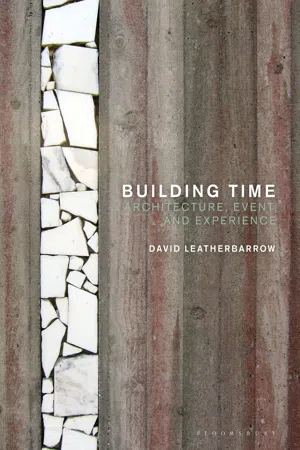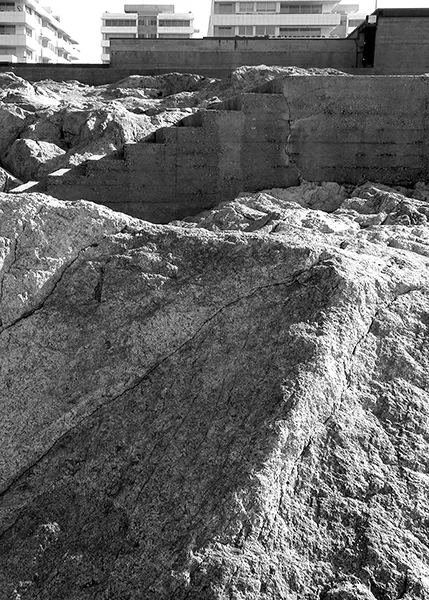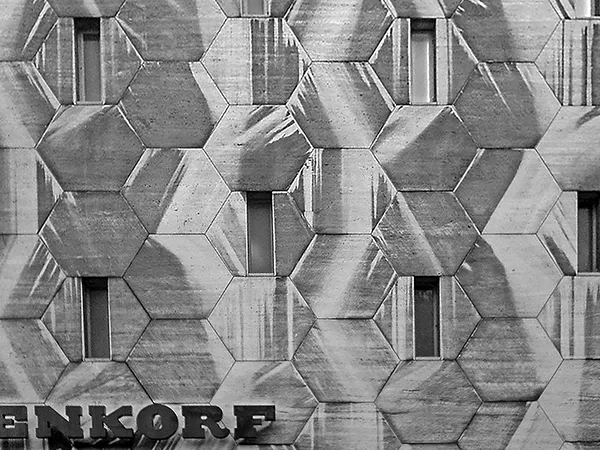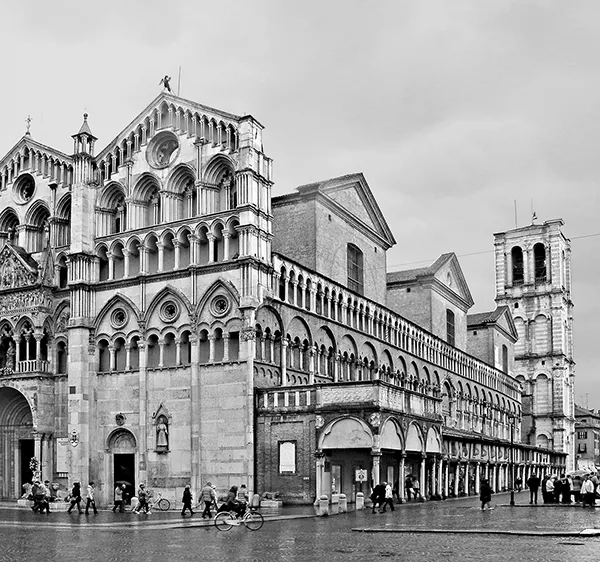![]()
Part One
Introduction
![]()
1.1
Making Space for Time
Forever—is composed of Nows—
‘Tis not a different time—
EMILY DICKINSON, n. 624, c. 1860
Architecture, it is said, results from the thoughtful making of space.1 But time is the dimension in which buildings actually come to life: how their shadows and steel engage the days and seasons of the world, how they guide the movements of people and things, and how they project the past into the future, the once-was into the could-be. Time is not a contingent attribute of the places intended in design and realized through construction but a key dimension of their structure and significance.
Perhaps it’s no surprise that time gets little direct attention in an art dedicated to permanence. Once they’re built, we expect rooms, houses, and offices to remain as they were, as if time hadn’t passed or didn’t matter—here they are, still ready for use, available now as before, rather like one’s body. Although much in life changes, buildings seem not to. When we stop to think about it, probably some differences between appearances then and now will be allowed, changes that result from deterioration, refinishing, alterations, and so on. These are of course changes of state, not position. Even so, when compared to the aspects of furnishings and rooms that are presently apparent, qualities that once were and will be, former and future phases hardly matter—and that’s by design. An architectural work is complete when what’s meant to remain has been realized. As months fade into years, the once-was and the now stand shoulder to shoulder, as if concurrent, no matter if the floor, walls, and roof are a little worse-for-wear, having suffered the effects of inhabitation and environmental influence. Endurance is a building’s most basic task and chief ambition.
Uncontroversial as these truisms might seem, they are contradicted by the fact that the building’s “photo-ready” or “move-in” condition never lasts very long, hardly more than a season, certainly not through the years and decades of its use, well after the builders have left the site. The first hour of inhabitation inaugurates a history of modifications that only ends when the building falls to ruin or is demolished. Even then traces remain, and thereby supply memory with a secure foothold, not only for one’s own recollection, but more importantly for collective memory: traces of the Wall in Berlin, for example, or that same city’s Memorial Church on Kurfürstendamm. Famous examples aside, the beginnings of the end are often trivial. First come scuffs on the floor and marks on the walls, then re-painting and re-furnishing, leading to the insertion of new doors, windows, or partitions, and the still more significant subtractions and additions that will come later. Succession follows on the heels of inception; new appearances supplant old, veiling the initial conception, although their appearance rarely attracts notice. Retrospective views of resemblance do not overcome; they reaffirm these differences. My thesis is that a key task of design is making space for this kind of time, the time of continual change, without, however, disavowing the desire for permanence.
Figure 1.1.1 Álvaro Siza, Leça da Palmeira Pools, view from shore to city. Photograph David Leatherbarrow.
Everyone likes landscapes of newly fallen snow, before they’re spoiled when the day begins. Pristine buildings have a similar appeal, before the residents move in. When trying to describe the settings in which we actually live our lives, however, there is no good reason to privilege a work’s first over its later appearances, nor to judge any present condition as necessarily superior to those that preceded and will follow it. The tendency among professionals, professors, and critics to concentrate on the qualities of the work that display the designer’s intentions is a disciplinary prejudice that neglects the reality of a building’s post-professional life. I realize this observation runs against the grain of most building restoration campaigns, no matter whether they are undertaken by preservationists, historians, or the designers themselves. The target of their efforts is normally the work’s uninhabited condition, before its years of suffering began.
The truth of the matter is that many buildings improve over time. Maintenance doesn’t always wind the building’s clock backwards.2 Improvements can result from modifications that compensate for inadequate foresight or faulty execution on the construction site. Positive changes can also result from the installation and operation of manual instruments or digital devices that improve a work’s usefulness. They alter its appearance as well. Today, buildings that incorporate some of these devices are said to be “intelligent.” A smart façade, for example, is one that incorporates instruments that moderate climate, accepting or rejecting free energy from the external environment, while reducing the amount of artificial energy required to achieve comfortable internal conditions. Materials, too, can be smart, which is to say endowed with their own manner of intelligence, more or less successfully and reliably.
But design is not required for changes to occur; alterations can also result from a work’s natural tendency to settle into its location, absorbing into its physical body qualifications that can render it more congenial to ambient conditions, including light, air, and temperature together with patterns of use and, more broadly, cultural norms. Here the intelligence expressed by the work has its source in the world, not the design. Taking the long view, it would seem that buildings have no choice but to submit themselves to re-qualifications of this kind, for though they are often unforeseen they are also unavoidable. Cumulatively, they would seem to be fateful. Georg Simmel, speaking of material change in his essay on ruins, said that in every instance of building nature eventually reclaims what was taken from it.3 Progress toward that end takes many forms. Considering surface alterations, for example, the spectrum ranges very widely, from bleaching, absorption, saturation, and staining, to polishing and abrasion. One of the most well-known instances of abrasion—not from natural but human forces—is the dishing of stairway treads that occurs over years of use, a re-profiling to which thousands of anonymous individuals contribute unknowingly. The result is not only prominently visible, but also usefully legible, showing the path most have preferred. Another eloquent example is the festive or seasonal whitewashing of vernacular buildings.4 Obviously, this practice is subtended by extra-architectural ideas and traditions—on the Christian calendar Easter renewal, for example.
Forces at play in the ambient environment also remake architectural appearances: a building’s sun and shade sides show different degrees of both chromatic intensity and variation—likewise, the alternately prominent and recessed parts of a single façade, such as the wooden panels on Kahn’s Salk Institute. The power of light and shadow to animate an architectural surface is similarly obvious. Recently, Kengo Kuma developed a theory of “particles” that elaborates this basic fact of building under the sun.5 Alterations that result from the sedimentation of air-borne particles are also familiar. Surface marks sometimes enrich, sometimes stain.6 Although soiled often means spoiled, stains on buildings don’t always suggest someone or something was at fault. In the case of Marcel Breuer’s De Bijenkorf Department Store, a radically different façade has resulted from this type of alteration. One doubts he anticipated the improbable pattern but suspects he liked it.
Figure 1.1.2 Wells Cathedral, Chapter House steps. Photograph David Leatherbarrow.
Figure 1.1.3 Louis I. Kahn, Salk Institute. Photograph David Leatherbarrow.
Figure 1.1.4 Kengo Kuma, Hiroshige Museum. Photograph David Leatherbarrow.
Figure 1.1.5 Marcel Breuer, De Bijenkorf Department Store. Photograph David Leatherbarrow.
Changes that are unforeseen, resulting from non-professional “agencies,” interest me the most because they often enrich works in ways that exceed what design intended. Even if we postpone judgments about the merit of modifications that were never envisaged, I think we must admit that unforeseen changes are inescapable in works that last and therefore should be taken into consideration in any account of their concrete reality, as well as in initial designs that did not clearly foresee but permitted them. Might that be a measure of the project’s intelligence: its capacity to absorb unanticipated effects and benefit from the result?
Nevertheless, when given just a little thought, the temporality that is peculiar to architecture seems contradictory. In architecture, time maintains what it has brought into being while it simultaneously schedules the work’s transformation, ultimately its disintegration. How can the two—sameness and difference—occur concurrently?
By virtue of its physicality, suitability, and familiarity, every work keeps its past present; now, like then, the walls of this room are still plaster, timber, and glass; its apertures and furnishings continue to allow one to use it as others have and will; in time it will still be this room. During any of these uses, the distinction between what the setting once was and now is has no real force. The only aspects of settings that show themselves to be “of the past” are the few that have lost their tacit relevance. In a larger sense, this is the difference between living tradition and history. Practical involvements abrogate the distinction between now and then, particularly when that difference has been hardened into a categorical separation. The chief impediment to grasping the reality of change is our uncritical dedication to objective or clock time, as opposed to the time of events, examples of which would include any instance of residing—talking with friends in your apartment, or working in your office, or watching a movie in your hotel room. On this point, William Faulkner offered a blunt observation: “Time is dead as long as it is being clicked off by little wheels; only when the clock stops does time come to life.”7
Thanks to the qualities I have just mentioned (physicality, suitability, and familiarity) every built setting not only recalls its past, but it also pre-figures its future. In the case of a lecture room, pre-figuration would anticipate the time when the next speaker or conference will begin, or more prosaically when the floor will be cleaned, the lighting repaired, or the overall appearance renewed. In other words, the room’s present state continually outruns itself toward its yesterday and tomorrow, impinging on each of them simultaneously. Here is the key point: temporality is not only nor always moment-by-moment succession. The chronology of regular intervals, clock time, is not lived time, as Faulkner said. The past lingers into the present, just as the future prolongs it; every now is also a former future and every future is at the same time a present yet to come.8 Current times in the living reality of an architectural work reassert the presence of a history which they also supersede, while they concurrently anticipate what is yet to come, though incompletely. My general point is that past and future define essential dimensions of the work’s present reality, albeit as conditions that are no longer and not yet present in the way they once were and will be. Accordingly, we need to reconsider what is conventionally meant by the “completion” of the design and construction processes. Building materials are pre-qualified in the quarry or factory—that’s how they recommend themselves for use—then they are qualified through the labors of construction, and lastly are re-qualified through patterns of practical use and environmental influence. This means the labor of finishing precedes itself and never comes to an end.9 Can we think of built works as necessarily unfinished? More importantly, can or should we design them with this in mind?
Finally, the temporal order that seems to be contradictory—now plus then—unfolds at several levels. Every built work, and by that I mean every room, building, garden, and urban setting, has a stratified temporal horizon, from which it obtains definition and in which it renews itself. I will explain the levels or kinds of building time below.
But here I’d like to propose a more compact version of my opening thesis: architectural permanence realizes itself in time. I say in time, not through time, not diachronically, as the philosophers say or, pathologically, as Aldo Rossi once said, but synchronically, or, in Rossi’s terms, a propelling sort of permanence that allows adaptations and alterations.10 To exemplify propelling permanence he mentioned the Palazzo Ragione at Padova. An even more vivid and eloquent case, I think, is the Cathedral in Ferrara, particularly the additions and alternations to the flanking walls of the nave, coupling in a fascinating way external shops with the side chapels within the church.
Figure 1.1.6 Ferrara Cathedral. Photograph David Leatherbarrow.
A thesis that may be more controversial is implied in this image of the past remaining present in works of architecture; namely, that buildings exist not only in but as ...






